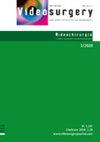A randomized controlled trial of emergency LCBDE + LC and ERCP + LC in the treatment of choledocholithiasis with acute cholangitis
IF 1.6
4区 医学
Q2 SURGERY
引用次数: 6
Abstract
Introduction Emergency biliary drainage is the basic treatment for acute cholangitis caused by choledocholithiasis. Aim To compare the effectiveness and safety of emergency laparoscopic common bile duct exploration combined with laparoscopic cholecystectomy (LCBDE + LC) and endoscopic retrograde cholangiopancreatography combined with laparoscopic cholecystectomy (ERCP + LC) for the treatment of choledocholithiasis combined with grade I or II acute cholangitis. Material and methods A total of 80 patients were enrolled in the study, with 40 cases in each group. A prospective randomized controlled study method was adopted, and the eligible patients were randomly divided into two groups in a ratio of 1 : 1 and treated with emergency LCBDE + LC and ERCP + LC, respectively. The relevant clinical data of the two groups were compared. Results The operation duration was longer and blood loss was greater in the LCBDE + LC group than in the ERCP + LC group, but the therapeutic cost was significantly lower in the former than in the latter. The differences were statistically significant (p < 0.05 in all). There was no severe complication in either group. The total number of cases with complications, incidence of postoperative acute pancreatitis and incidence of hemorrhage were higher in the ERCP + LC group than in the LCBDE + LC group, while the incidence of bile leakage was lower in the former than in the latter. The differences were statistically significant (p < 0.05 in all). Conclusions Both protocols were safe and feasible in the management of grade I or II acute calculous cholangitis. Compared with the protocol of ERCP + LC, the protocol of LCBDE + LC had the advantages of fewer complications and lower therapeutic costs and is worthy of clinical promotion.急诊LCBDE + LC和ERCP + LC治疗胆总管结石合并急性胆管炎的随机对照试验
急诊胆道引流是胆总管结石引起的急性胆管炎的基本治疗方法。目的比较急诊腹腔镜胆总管探查联合腹腔镜胆囊切除术(LCBDE + LC)与内镜逆行胆管造影联合腹腔镜胆囊切除术(ERCP + LC)治疗胆总管结石合并I级或II级急性胆管炎的有效性和安全性。材料与方法共80例患者入组,每组40例。采用前瞻性随机对照研究方法,将符合条件的患者按1:1的比例随机分为两组,分别给予急诊LCBDE + LC和ERCP + LC治疗。比较两组患者的相关临床资料。结果LCBDE + LC组比ERCP + LC组手术时间更长,出血量更大,但治疗费用明显低于ERCP + LC组。差异均有统计学意义(p < 0.05)。两组均无严重并发症。ERCP + LC组并发症总例数、术后急性胰腺炎发生率、出血发生率均高于LCBDE + LC组,胆漏发生率低于LCBDE + LC组。差异均有统计学意义(p < 0.05)。结论两种治疗方案对ⅰ、ⅱ级急性结石性胆管炎是安全可行的。与ERCP + LC方案相比,LCBDE + LC方案具有并发症少、治疗费用低的优点,值得临床推广。
本文章由计算机程序翻译,如有差异,请以英文原文为准。
求助全文
约1分钟内获得全文
求助全文
来源期刊
CiteScore
2.80
自引率
23.50%
发文量
48
审稿时长
12 weeks
期刊介绍:
Videosurgery and other miniinvasive techniques serves as a forum for exchange of multidisciplinary experiences in fields such as: surgery, gynaecology, urology, gastroenterology, neurosurgery, ENT surgery, cardiac surgery, anaesthesiology and radiology, as well as other branches of medicine dealing with miniinvasive techniques.

 求助内容:
求助内容: 应助结果提醒方式:
应助结果提醒方式:


